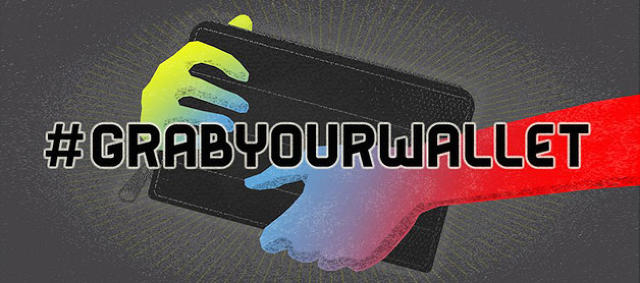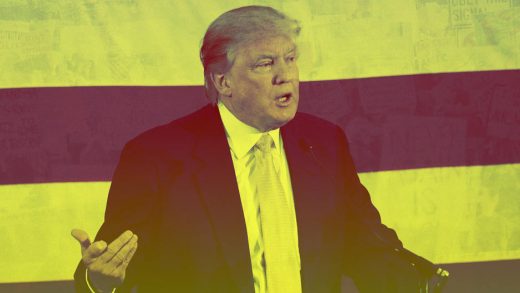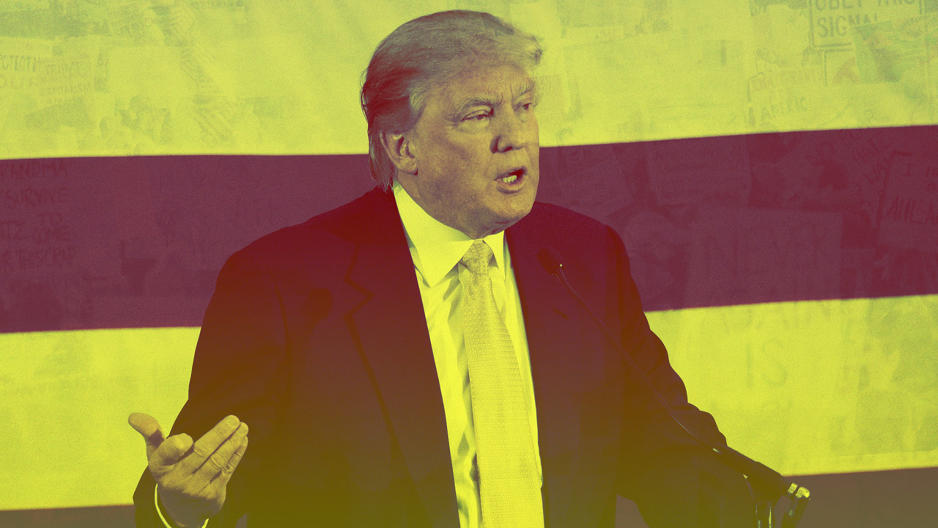Five Ways Boycotts Have Been Transformed In The Trump Era
“Boycotts are as American as apple pie,” says Shannon Coulter, calling it a tradition that started with the Boston Tea Party in 1773. Inspired by that heritage and motivated by her outrage over Donald Trump’s political ascendance, the digital strategist launched her own boycott, #GrabYourWallet, on October 11, 2016. What began as a spreadsheet of companies connected to the Trump family has grown into an international campaign that’s already claiming victories, such as Nordstrom, Kmart, and Sears dropping Ivanka Trump’s fashion line all within the last week. Coulter’s project is a prime example of how boycotts have changed radically in the Trump era—both in aims and methods. They are moving away from targeted campaigns with specific demands—desegregate buses, end sweatshop labor—to acts of political rebellion: Repudiate Trump, defund Breitbart News.
Changes in party affiliation and media consumption already underway for a decade have been supercharged by the unprecedented arrival of a president who is also a political neophyte and media personality. With a fiercely divided country capable of a hair-trigger response through social media, Trump’s rise has led to these five new phenomena in economic protest.
Boycotter In Chief
Presidents have always had the bully pulpit, but Trump takes it to a new level with his pop culture celebrity and Twitter virtuosity. Going straight to social media, Trump can make bold claims and pronouncements that would never be acceptable in an Oval Office speech or State of the Union address. “What we’re seeing now is politicians calling for boycotts, which we have not historically seen outside of perhaps the Civil Rights movement,” says University of Texas at Austin professor Tim Werner, who specializes in corporate social responsibility and government policy.
Trump started as a candidate in July 2015, urging people to boycott Macy’s after the retailer dumped his brand of shirts and ties because of his incendiary claim about “Mexican rapists.” Now as a president, he can set his followers in motion with just a tweet, as he did when Nordstrom last week dropped Ivanka Trump’s fashion line. “He didn’t outright call for a boycott, but Trump supporters are calling for a boycott of Nordstrom precisely because of this call to arms,” says Brayden King, a professor at Northwestern University who studies how activism affects corporations.
The Trump-inspired boycotts haven’t had a financial impact; but boycotts almost never do, say King and Werner. The main goal is to generate publicity, which Trump certainly does.
Boycottee In Chief
Never has a U.S. president also been a consumer brand. Trump’s name is on hotels, condos, golf courses, clothing, food, TV shows, and more—all targets for his opponents. #GrabYourWallet lists about 70 companies somehow tied to Trump—especially to the Ivanka Trump brand
. The campaign’s goal is, “to shop with a clear conscience and no bad memories,” says Shannon Coulter, who started #GrabYourWallet after the pussy-grabbing and other sexist comments captured on the infamous Access Hollywood recording. (Other activists have created boycott-focused mobile apps that list companies connected to Trump.)
Ivanka became a bigger target because of how she reacted to the tapes, says Coulter. “After she not only went back out on the campaign trail but went back full-bore, I think that [people] were less willing to cut her that slack,” she says. Major retailers that have dropped Ivanka’s and other Trump family brands tend to say it’s a business decision due to poor sales, but it’s pretty clear that the boycott helped turn off potential customers. Nordstrom is just the most prominent on an ever-growing list including Nordstrom Rack, Bellacor, Jet, Kmart, Neiman Marcus, Rue La La, Sears, Shoes.com, and Zulify.
“I think it would be wildly unrealistic of me to expect large, publicly traded retailers to attribute their actions to the boycott,” says Coulter. “However, I have absolutely no doubt that the boycott was instrumental in their decision to drop Trump products.” The popularity of the Ivanka Trump brand has been plummeting at Nordstrom since October, reports the Wall Street Journal. “Maybe this is the one time when consumers are so politically polarized that it actually is affecting every choice that they make,” says King.
Political Statement Boycotts
Boycotts used to include specific demands, like for Nike to improve labor conditions; and about a quarter of them create enough pressure for the company to make concessions, says Werner. Today’s boycotts, on the left and the right, instead are often political statements. There is very little the target can do to please its antagonists, other than to pack up and go home.

#GrabYourWallet isn’t even targeting the Trump family, but rather companies that do business with them or that supported the campaign. Success means hurting Trump, not persuading him to rescind the travel ban, preserve funding for EPA, or nominate a different secretary of education. (However, Coulter says that #GrabYourWallet may evolve to leverage consumer pressure on other causes beyond Trump.)
Right-wing boycotts have also sought to punish, rather than reform. When Kellogg’s pulled its advertising from Breitbart News, the outlet called for a boycott—which, unsurprising to boycott experts, did no financial harm to the cereal giant. That doesn’t mean it failed. “I don’t believe Breitbart ever thought that Kellogg’s would come running back with its tail between its legs,” says King. One goal may have been to intimidate other advertisers considering bolting, he says. “The other was that they just wanted to make a point. Breitbart thrives on taking political stances on issues that resonate for its readership.”
The B2B Boycott
That practice has made Breitbart the target of another spreadsheet boycott campaign called Sleeping Giants—a list of about 1,000 organizations persuaded to pull their ads from the news site. People who see Breitbart as racist and sexist probably aren’t customers and can’t do a traditional boycott. But they are trying to hit its revenue by taking screenshots of ads that appear on Breitbart and tweeting them to the advertisers. “A lot of these companies—almost everyone we reach out to—has said, ‘Oh my God, I didn’t realize it was on there!” says a Sleeping Giants organizer, who like all the members, remains anonymous. (“We’re in a related field, digital marketing,” he tells me, “and we don’t want it to get mixed up with our clients.”)
This inadvertent sponsorship is the product of programmatic advertising—services like AppNexus and Google’s DoubleClick that automatically bid for slots and place ads on websites. Companies, universities, or other organizations don’t pick the sites that their ads go on; but they can blacklist sites they want to stay off of, which the Sleeping Giants participants have done. The list includes progressive businesses like the Honest Company and Warby Parker, but also giant multinationals from 3M and Mercedes-Benz to Visa and Lenovo. AppNexus has blacklisted Breitbart from its entire network, as have smaller networks Rocket Fuel and TubeMogul. “Google’s a big one,” says the guy from Sleeping Giants. “We have not heard anything back from them.”
Sleeping Giants was inspired by a boycott project called “Stop Funding Hate,” which targets advertisers in British tabloids that publish race-baiting articles. Both organizations now expanded outside their home countries, to places like Austria, New Zealand, and Switzerland.

Already hammering at its advertising, Breitbart foes are now going after its online store, powered by e-commerce platform Shopify. On February 8, Shopify’s CEO, Tobias Lütke, published a post on Medium saying that, for reasons of free speech, he was rejecting calls to cut ties with Breitbart. Now Shopify itself may be a boycott target, with pressure from activists groups like petition site SumOfUs. “We are looking into reaching out to Shopify employees and also companies that do business with it,” says SumOfUs lead campaign strategist Emma Pullman in an email. “The #GrabYourWallet community is very happy to use the platform we’ve built to help shine a light on the fact that Shopify powers the Breitbart store and to inspire them to do otherwise,” writes Shannon Coulter in an email.
Boycott Fatigue
The internet accelerates everything, and the speed it’s brought to boycotts has been stunning—especially in the #DeleteUber campaign. But the media saturation that led to success in the Uber campaign may not bode well for other boycotts.
Uber CEO Travis Kalanick angered Trump opponents by joining the president’s Strategic and Policy Forum. Then on January 28, Uber made a temporary change in rates that people saw as undercutting an airport taxi strike supporting protests against Trump’s travel ban. More than 200,000 people ditched the Uber app in protest, reports the Times, and downloads of rival app Lyft surged. On February 2, Kalanick quit the forum.
That’s not a success likely to be repeated. Substituting Lyft for Uber was a no-brainer for activists. “There’s no real trade-off between the two services, not to mention the drivers are the same people,” says Brayden King.
Most boycotts are a lot harder and take a lot longer. The efforts to reform Nike’s labor practices began in the 1990s and took years to get the company to implement changes. Will activists be able to stay focused that long, when other boycotts, also launched at lightning speed, keep popping up to compete for attention? “We’re just overrun with boycotts at the moment,” says King.
It’s not just activists who are losing focus. So is the market. Given that most boycotts don’t hurt sales much (even Uber seems to have bounced back), a boycott’s biggest tool is bad publicity, which can affect stock prices. That’s happening less, says King. There is plenty of media attention around boycotts, but it’s diluted by the sheer number of them. “It’s the only time I’ve ever said that,” says King. “I think this month we may be starting to see boycott fatigue.”
Fast Company , Read Full Story
(40)



